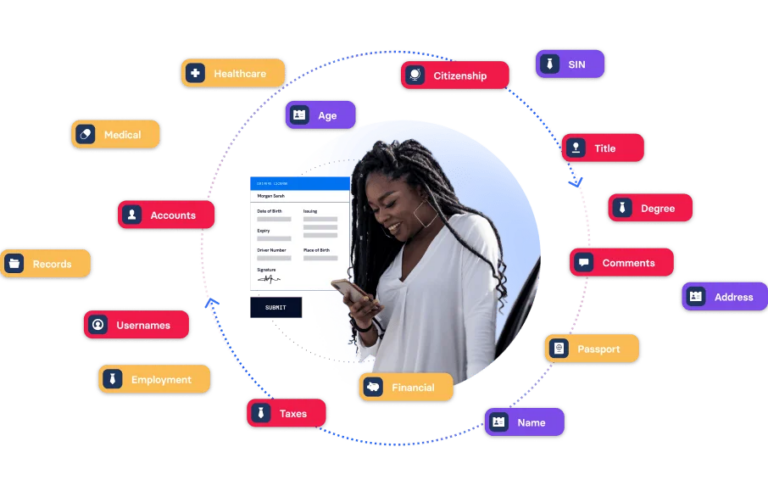
Economic growth and innovation in Canada are a priority as our communities look to get back on track post-pandemic. But there’s a fundamental gap in the way of us getting there: our digital identity and data security standards aren’t keeping pace with online activity.
Every year in Canada, the rate of cybercrime and identity theft continues to climb. In 2022, the reported losses from fraud were a staggering $500 million dollars. That’s nearly a 40% increase from 2021, with the pandemic driving a rise in cybercrime. This looks like everything from emptied bank accounts to hackers taking control of moving vehicles.
The way we tackle these challenges will have ripple effects on every corner of our digital life and digital commerce experiences. From the most complex tasks – like verifying a bank account – to the most routine experiences – like buying a coffee, or connecting with new service providers – personal data has become the lifeblood of our society’s digital interactions.
This increased volume of digital transactions has Canada at an inflection point when it comes to the current state of verification. As the existing methods continue to be targeted for fraud and cybercrime, putting unprecedented pressure on citizens and businesses alike.
The solution? We need a new data paradigm. One that puts robust digital identity verification tech, digital credentials, and new standards of user-driven privacy at the forefront.
Digital identity landscape in Canada
Despite ranking amongst the top 10 in a global scale of digital innovation, Canada is poised for modernization when it comes to combating fraud. Our policy, tech, and industry standards need to work together to shape a more secure environment, as more people live and transact online.
Macro trends aside, there’s a data-security challenge surrounding digital identification and individual credentials, specifically. Since Canada lacks a federally regulated digital ID program, upwards of 30 million people operate with paper-based IDs while opening bank accounts, checking into hotels, and crossing borders. This makes identity theft a major vulnerability for citizens and contributes to fraud across business operations.
A lack of digital identity credentials and standards has also created a unique compression in Canada’s financial institutions. Across all the industries that experienced rising fraud in 2021, digital fraud against financial services companies increased the most, rising a staggering 218% compared to the previous year. This included a mix of identity theft, account takeovers, and unauthorized activities involving financial institutions.
While the challenges in Canada’s privacy landscape are multi-layered – and cross-industry – it’s clear that decentralized digital IDs and identity tech stand to play a major role in changing these trends for the better.
What’s on the horizon for digital IDs
If launching a country-wide digital ID program can provide a more secure digital future, what does this look like?
Starting at the federal level, it means data and privacy standards are regulated fairly across public and private sectors, and tools for identity consent are made accessible to every citizen. Canadian institutions like DIACC (Digital Identification and Authentication Council of Canada) and PCTF (Pan-Canadian Trust Framework), are putting this into motion by developing a framework for national digital identification and authentication standards, setting the foundation for a federal launch.
For citizens, getting access to digital ID tech means more than having visibility – and a choice – on who is accessing their personal data. It means having ownership over what is shared, when, and with whom.
Digital wallet technology, for example, lets people store elements of their digital identity as “credentials”, with key information like a driver’s license, birthdate, and photos encrypted on the wallet, accessible right from a cell phone. Adoption of a digital ID and identity wallets would enable selective data sharing, all while safeguarding the data using decentralized technology.
Investment in this area could also create major savings for businesses as well. Not only would the tech protect against fraud itself, having more streamlined tools would save businesses from costly ID verification and compliance fees. The current methods used to verify, store, and recover customer data (in the event of a data breach) costs businesses hundreds of millions of dollars each year. Smoother user verification processes will have knock-on effects for business profitability: the easier the onboarding experience, the lower the customer churn.
As Canada seeks to create an economy where everyone can thrive as an active digital citizen, harnessing the right privacy standards and technology will be key to enabling citizen accessibility while maintaining their privacy. With national digital identity programs on the horizon, the path forward is one to watch over the coming years.
Chandra Rink is the Managing Director, Head of Product & IP, ATB Ventures. She leads a multi-disciplinary team of product, research, marketing, and design specialists, who bring their expertise into experimentation and commercialization of ATB Ventures’ product portfolio.




Why does the conversation around digital ID’s always promote the benefits and never raise any concerns about the very real possibility of misuse and over reach? There are many real world examples of controlling agenesis/governments who use their power to control the users who do not follow their agenda. The Chinese governments Social Scoring Program and the Canadian governments response to protests and resistance to their COVID policies are two examples where citizens have and are being punished by removing their livelihoods and freedom to travel.
The benefits of digital ID seem centered around security and streamlining the system. Worthy goals. But with all the sharp talent in the world there are just as effective and less dangerous ways to achieve those goals. I think the old axiom ‘there’s more than one way to skin a cat’ applies here. And just to be clear. There is no way to guarantee that ways to get around the security promised isn’t already being developed.
Great comment! Glad someone voiced it as it states exactly my concerns.
My own personal ones are:
What happens when a person doesn’t have a cell phone to be able to show their ID? I don’t.
What happens to those of us that only use cash?
Will a person be able to opt out of the ID system if they want to?
This whole thing seems to me to be “safe and effective” only for a government that wants to control their population.